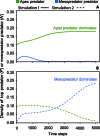Ecosystem context and historical contingency in apex predator recoveries
- PMID: 27386535
- PMCID: PMC4928970
- DOI: 10.1126/sciadv.1501769
Ecosystem context and historical contingency in apex predator recoveries
Abstract
Habitat loss, overexploitation, and numerous other stressors have caused global declines in apex predators. This "trophic downgrading" has generated widespread concern because of the fundamental role that apex predators can play in ecosystem functioning, disease regulation, and biodiversity maintenance. In attempts to combat declines, managers have conducted reintroductions, imposed stricter harvest regulations, and implemented protected areas. We suggest that full recovery of viable apex predator populations is currently the exception rather than the rule. We argue that, in addition to well-known considerations, such as continued exploitation and slow life histories, there are several underappreciated factors that complicate predator recoveries. These factors include three challenges. First, a priori identification of the suite of trophic interactions, such as resource limitation and competition that will influence recovery can be difficult. Second, defining and accomplishing predator recovery in the context of a dynamic ecosystem requires an appreciation of the timing of recovery, which can determine the relative density of apex predators and other predators and therefore affect competitive outcomes. Third, successful recovery programs require designing adaptive sequences of management strategies that embrace key environmental and species interactions as they emerge. Consideration of recent research on food web modules, alternative stable states, and community assembly offer important insights for predator recovery efforts and restoration ecology more generally. Foremost among these is the importance of a social-ecological perspective in facilitating a long-lasting predator restoration while avoiding unintended consequences.
Keywords: Restoration; apex predator; competition; food chain; hysteresis; intraguild predation; recovery.
Figures





Similar articles
-
Transient dynamics during kelp forest recovery from fishing across multiple trophic levels.Ecol Appl. 2021 Sep;31(6):e02367. doi: 10.1002/eap.2367. Epub 2021 Jun 10. Ecol Appl. 2021. PMID: 33938605
-
Predator interactions, mesopredator release and biodiversity conservation.Ecol Lett. 2009 Sep;12(9):982-98. doi: 10.1111/j.1461-0248.2009.01347.x. Epub 2009 Jul 14. Ecol Lett. 2009. PMID: 19614756 Review.
-
The changing contribution of top-down and bottom-up limitation of mesopredators during 220 years of land use and climate change.J Anim Ecol. 2017 May;86(3):566-576. doi: 10.1111/1365-2656.12633. Epub 2017 Feb 28. J Anim Ecol. 2017. PMID: 28075011
-
Fire as a driver and mediator of predator-prey interactions.Biol Rev Camb Philos Soc. 2022 Aug;97(4):1539-1558. doi: 10.1111/brv.12853. Epub 2022 Mar 23. Biol Rev Camb Philos Soc. 2022. PMID: 35320881 Free PMC article. Review.
-
Small but powerful: top predator local extinction affects ecosystem structure and function in an intermittent stream.PLoS One. 2015 Feb 25;10(2):e0117630. doi: 10.1371/journal.pone.0117630. eCollection 2015. PLoS One. 2015. PMID: 25714337 Free PMC article.
Cited by
-
Loss of Sunda clouded leopards and forest integrity drive potential impacts of mesopredator release on vulnerable avifauna.Heliyon. 2024 Jun 11;10(12):e32801. doi: 10.1016/j.heliyon.2024.e32801. eCollection 2024 Jun 30. Heliyon. 2024. PMID: 38975237 Free PMC article.
-
"Spotting" Mycobacterium bovis infection in leopards (Panthera pardus) - novel application of diagnostic tools.Front Immunol. 2023 Sep 1;14:1216262. doi: 10.3389/fimmu.2023.1216262. eCollection 2023. Front Immunol. 2023. PMID: 37727792 Free PMC article.
-
Otterly delicious: Spatiotemporal variation in the diet of a recovering population of Eurasian otters (Lutra lutra) revealed through DNA metabarcoding and morphological analysis of prey remains.Ecol Evol. 2023 May 10;13(5):e10038. doi: 10.1002/ece3.10038. eCollection 2023 May. Ecol Evol. 2023. PMID: 37181211 Free PMC article.
-
COVID-19 lockdown reveals tourists as seabird guardians.Biol Conserv. 2021 Feb;254:108950. doi: 10.1016/j.biocon.2021.108950. Epub 2021 Jan 4. Biol Conserv. 2021. PMID: 35719894 Free PMC article.
-
Conservation implications of forage base requirements of a marine predator population at carrying capacity.iScience. 2021 Dec 16;25(1):103646. doi: 10.1016/j.isci.2021.103646. eCollection 2022 Jan 21. iScience. 2021. PMID: 35024583 Free PMC article.
References
-
- Sergio F., Schmitz O. J., Krebs C. J., Holt R. D., Heithaus M. R., Wirsing A. J., Ripple W. J., Ritchie E., Ainley D., Oro D., Jhala Y., Hiraldo F., Korpimäki E., Towards a cohesive, holistic view of top predation: A definition, synthesis and perspective. Oikos 123, 1234–1243 (2014).
-
- Yodzis P., Must top predators be culled for the sake of fisheries? Trends Ecol. Evol. 16, 78–84 (2001). - PubMed
-
- Estes J. A., Terborgh J., Brashares J. S., Power M. E., Berger J., Bond W. J., Carpenter S. R., Essington T. E., Holt R. D., Jackson J. B. C., Marquis R. J., Oksanen L., Oksanen T., Paine R. T., Pikitch E. K., Ripple W. J., Sandin S. A., Scheffer M., Schoener T. W., Shurin J. B., Sinclair A. R. E., Soulé M. E., Virtanen R., Wardle D. A., Trophic downgrading of planet Earth. Science 333, 301–306 (2011). - PubMed
-
- Ripple W. J., Newsome T. M., Wolf C., Dirzo R., Everatt K. T., Galetti M., Hayward M. W., Kerley G. I. H., Levi T., Lindsey P. A., Macdonald D. W., Malhi Y., Painter L. E., Sandom C. J., Terborgh J., Van Valkenburgh B., Collapse of the world’s largest herbivores. Sci. Adv. 1, e1400103 (2015). - PMC - PubMed
-
- Soulé M. E., Estes J. A., Berger J., del Rio C. M., Ecological effetiveness: Conservation goals for interactive species. Conserv. Biol. 17, 1238–1250 (2003).
Publication types
MeSH terms
LinkOut - more resources
Full Text Sources
Other Literature Sources
Miscellaneous


